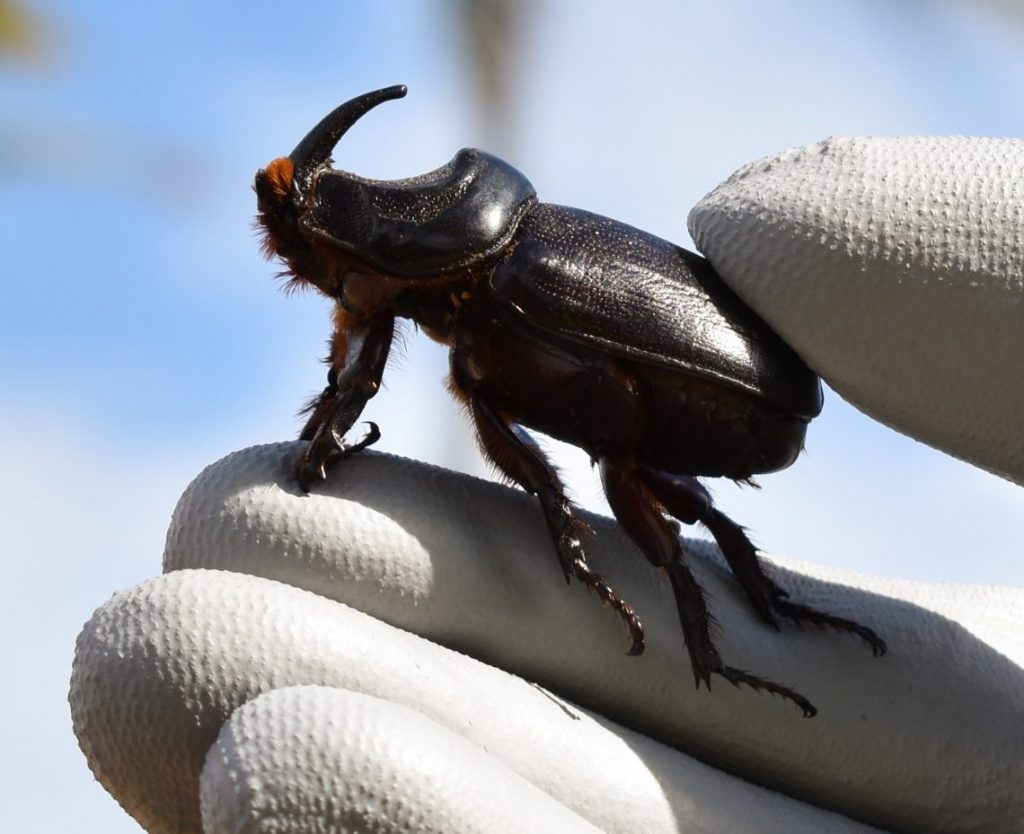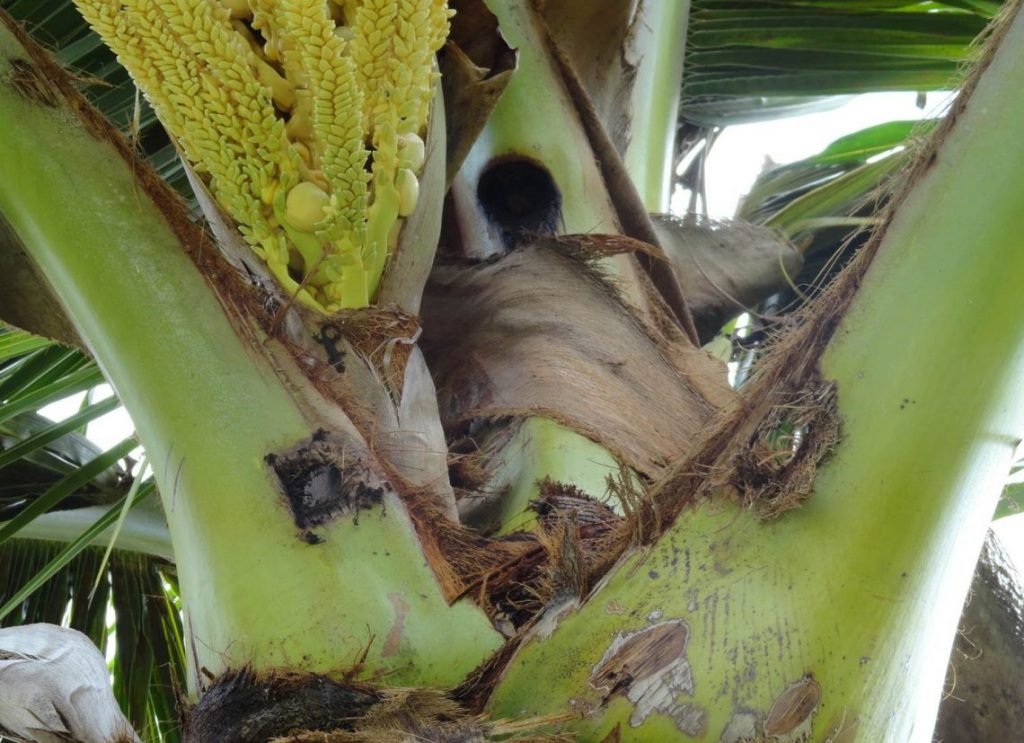A large, invasive beetle is spreading on Oʻahu. First detected in December 2013 at a golf course near the Honolulu airport, the coconut rhinoceros beetle (CRB) was confined to central and west Oʻahu during the early years of the infestation, thanks to the work of Coconut Rhinocerous Beetle Response – the interagency team that formed to address it. But since the summer of 2022, the project has seen an explosion of detections, with CRB infestations discovered at new locations on the island. The beetles have not been detected on any of the neighbor islands, but it’s likely just only a matter of time before they arrive.

Coconut palms are the preferred host, but the beetles also live on other palms, banana trees, sugar cane, agave, and even ironwood, taro, and hala. Mature coconut trees can typically withstand feeding damage, but juvenile plants often die. Over time, as mature trees age out, an entire species of palm can disappear. Endangered native palms – loulu – are especially at risk.
At 2 ½ inches long, these large, black beetles are nocturnal and can fly up to two miles, spending most of their lives hidden high in the tops of coconuts, boring into the crowns of healthy palm trees. Adults bore through unopened leaves to feed on the sap. An adult female beetle emerges from the crown to lay up to 140 eggs in its lifetime in nearby mulch piles or decomposed tree stumps. Plump, brown-headed larvae with bluish-grey tails are huge – ranging from two to four inches long.
Through a coordinated partnership with the University of Hawaiʻi, U.S. Department of Agriculture, Hawaiʻi Department of Agriculture (HDOA), and other key organizations, the Coconut Rhinoceros Beetle Response team has been working to stem the tide of this invasive pest on Oʻahu. The team’s multi-pronged strategy includes the placement of pheromone traps, detector dogs, treatment of high-risk materials, quarantine protocols, research, and outreach. Arisa Barcinas is the Outreach Specialist for CRB Response, and champions successful control of CRB. “When green waste is managed properly,” she explains, “It can drastically reduce an infestation and allow damaged palms to grow back.”

The beetles spread to new places by hitchhiking in the holds of aircraft and through movement of nursery stock, compost, and mulch. To contain the beetle and prevent its spread to other islands, HDOA declared Oahu a CRB quarantine zone. Businesses must complete a series of steps before moving high-risk material, like mulch or host palms. Before being shipped, HDOA inspects and treats the material using high heat or fumigation. If beetle damage is detected, plants don’t move. Plants and materials are inspected again at their destination to ensure there are no hitchhikers.
Early detection efforts have been in place to prevent the spread to other islands. The Maui Invasive Species Committee’s (MISC) Early Detection team conducts regular surveys for CRB. Staff on Maui and Molokai (Molokai Invasive Species Committee) monitor traps at the airport twice a month.
Prevention and reporting are critical to catching this pest early. Barcinas says, “It’s important to understand how devastating CRB can be if it spreads to other islands. Community involvement is crucial to prevent the establishment of this pest in other places.” Her team has been increasing its work on neighbor islands by installing more traps and coordinating logistics to bring over detection dogs for surveys.

The most obvious sign of this beetle’s presence are bore holes in the crowns of palm trees or v-cut formations in the leaves. Using mulch and compost right away by spreading it thinly, rather than storing it in piles, is another way to prevent beetle breeding habitat and undetected infestations. Suspect CRB on Maui should be reported immediately to 643pest.org. Make sure to upload a photo of the beetle and/or signs of damage and note the exact location in the report. A pest prevention training describing CRB and other invasive species is offered to nurseries and can be found at plantpono.org. More information about this pest and compliant businesses on Oʻahu are at crbhawaii.org.
Serena Fukushima is the public relations and education specialist for the Maui Invasive Species Committee. She holds a bachelor’s degree in environmental studies and a graduate degree in education from the University of Hawaii at Manoa. “Kia’i Moku, Guarding the Island” is written by the Maui Invasive Species Committee to provide information on protecting the island from invasive plants and animals that threaten our islands’ environment, economy and quality of life.
This article was originally published in the Maui News on January 14, 2023 as part of the Kia‘i Moku Column from the Maui Invasive Species Committee.
Read more Kiaʻi Moku articles
